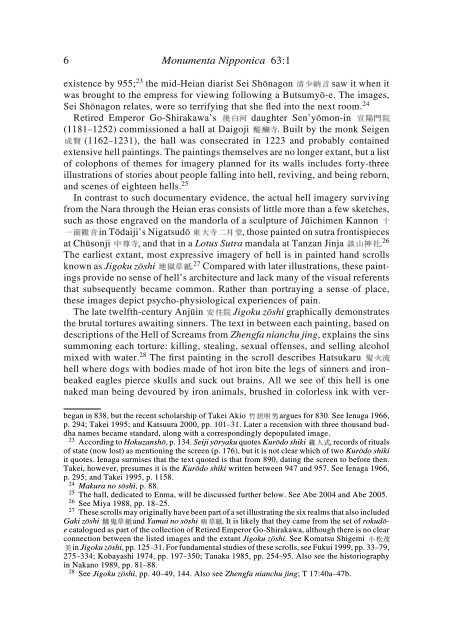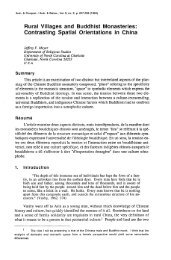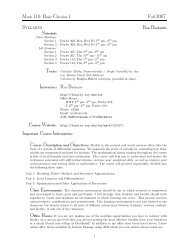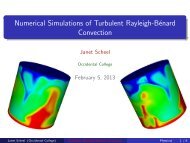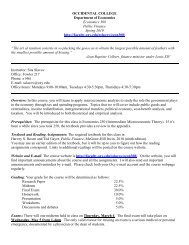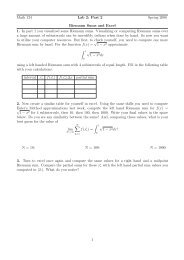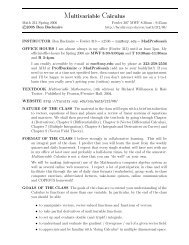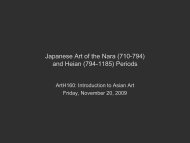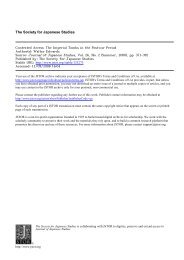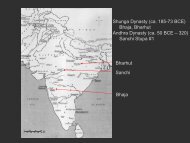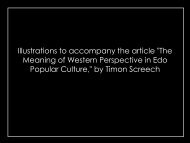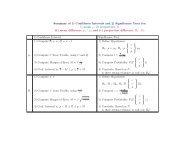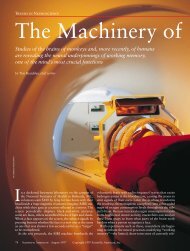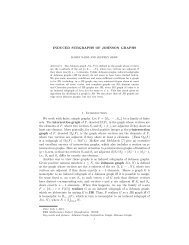A Primer on Japanese Hell Imagery and Imagination - Occidental ...
A Primer on Japanese Hell Imagery and Imagination - Occidental ...
A Primer on Japanese Hell Imagery and Imagination - Occidental ...
Create successful ePaper yourself
Turn your PDF publications into a flip-book with our unique Google optimized e-Paper software.
6<br />
M<strong>on</strong>umenta Nipp<strong>on</strong>ica 63:1<br />
existence by 955; 23 the mid-Heian diarist Sei Shônag<strong>on</strong> saw it when it<br />
was brought to the empress for viewing following a Butsumyô-e. The images,<br />
Sei Shônag<strong>on</strong> relates, were so terrifying that she fled into the next room. 24<br />
Retired Emperor Go-Shirakawa’s daughter Sen’yôm<strong>on</strong>-in<br />
(1181–1252) commissi<strong>on</strong>ed a hall at Daigoji . Built by the m<strong>on</strong>k Seigen<br />
(1162–1231), the hall was c<strong>on</strong>secrated in 1223 <strong>and</strong> probably c<strong>on</strong>tained<br />
extensive hell paintings. The paintings themselves are no l<strong>on</strong>ger extant, but a list<br />
of coloph<strong>on</strong>s of themes for imagery planned for its walls includes forty-three<br />
illustrati<strong>on</strong>s of stories about people falling into hell, reviving, <strong>and</strong> being reborn,<br />
<strong>and</strong> scenes of eighteen hells. 25<br />
In c<strong>on</strong>trast to such documentary evidence, the actual hell imagery surviving<br />
from the Nara through the Heian eras c<strong>on</strong>sists of little more than a few sketches,<br />
such as those engraved <strong>on</strong> the m<strong>and</strong>orla of a sculpture of Jûichimen Kann<strong>on</strong><br />
in Tôdaiji’s Nigatsudô<br />
, those painted <strong>on</strong> sutra fr<strong>on</strong>tispieces<br />
at Chûs<strong>on</strong>ji , <strong>and</strong> that in a Lotus Sutra m<strong>and</strong>ala at Tanzan Jinja . 26<br />
The earliest extant, most expressive imagery of hell is in painted h<strong>and</strong> scrolls<br />
known as Jigoku zôshi . 27 Compared with later illustrati<strong>on</strong>s, these paintings<br />
provide no sense of hell’s architecture <strong>and</strong> lack many of the visual referents<br />
that subsequently became comm<strong>on</strong>. Rather than portraying a sense of place,<br />
these images depict psycho-physiological experiences of pain.<br />
The late twelfth-century Anjûin Jigoku zôshi graphically dem<strong>on</strong>strates<br />
the brutal tortures awaiting sinners. The text in between each painting, based <strong>on</strong><br />
descripti<strong>on</strong>s of the <strong>Hell</strong> of Screams from Zhengfa nianchu jing, explains the sins<br />
summ<strong>on</strong>ing each torture: killing, stealing, sexual offenses, <strong>and</strong> selling alcohol<br />
mixed with water. 28 The first painting in the scroll describes Hatsukaru<br />
hell where dogs with bodies made of hot ir<strong>on</strong> bite the legs of sinners <strong>and</strong> ir<strong>on</strong>beaked<br />
eagles pierce skulls <strong>and</strong> suck out brains. All we see of this hell is <strong>on</strong>e<br />
naked man being devoured by ir<strong>on</strong> animals, brushed in colorless ink with ver-<br />
began in 838, but the recent scholarship of Takei Akio argues for 830. See Ienaga 1966,<br />
p. 294; Takei 1995; <strong>and</strong> Katsuura 2000, pp. 101–31. Later a recensi<strong>on</strong> with three thous<strong>and</strong> buddha<br />
names became st<strong>and</strong>ard, al<strong>on</strong>g with a corresp<strong>on</strong>dingly depopulated image.<br />
23 According to Hokuzanshô, p. 134. Seiji yôryaku quotes Kurôdo shiki , records of rituals<br />
of state (now lost) as menti<strong>on</strong>ing the screen (p. 176), but it is not clear which of two Kurôdo shiki<br />
it quotes. Ienaga surmises that the text quoted is that from 890, dating the screen to before then.<br />
Takei, however, presumes it is the Kurôdo shiki written between 947 <strong>and</strong> 957. See Ienaga 1966,<br />
p. 295; <strong>and</strong> Takei 1995, p. 1158.<br />
24 Makura no sôshi, p. 88.<br />
25 The hall, dedicated to Enma, will be discussed further below. See Abe 2004 <strong>and</strong> Abe 2005.<br />
26 See Miya 1988, pp. 18–25.<br />
27 These scrolls may originally have been part of a set illustrating the six realms that also included<br />
Gaki zôshi <strong>and</strong> Yamai no sôshi . It is likely that they came from the set of rokudôe<br />
catalogued as part of the collecti<strong>on</strong> of Retired Emperor Go-Shirakawa, although there is no clear<br />
c<strong>on</strong>necti<strong>on</strong> between the listed images <strong>and</strong> the extant Jigoku zôshi. See Komatsu Shigemi<br />
in Jigoku zôshi, pp. 125–31. For fundamental studies of these scrolls, see Fukui 1999, pp. 33–79,<br />
275–334; Kobayashi 1974, pp. 197–350; Tanaka 1985, pp. 254–95. Also see the historiography<br />
in Nakano 1989, pp. 81–88.<br />
28 See Jigoku zôshi, pp. 40–49, 144. Also see Zhengfa nianchu jing; T 17:40a–47b.


